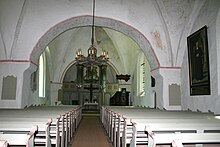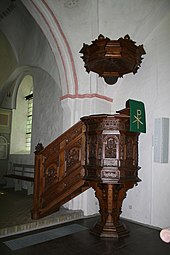Sieseby Church
The church of Sieseby in the municipality of Thumby is a field stone building from the 12th century in the listed village of Sieseby on the Schlei . It belongs to the Schwansen parish in the Evangelical Lutheran Church in Northern Germany .
history
The parish of Sieseby is first mentioned in a document dated August 15, 1267. The beginning of the church building dates back to the late 12th century. In its earliest form, the church consisted of a flat-roofed nave made of field stones with a retracted choir. This Romanesque building was expanded several times in the following centuries. Two smaller chapels were added to the south of the nave as early as 1300, of which the larger one serves as a memorial room for the fallen of the two world wars. Today there is a separate prayer room in the smaller side chapel. Around 1350 the choir was extended by a second yoke , since then the choir arch has been located roughly in the middle of the church. At the same time, the vaults in the choir and nave were drawn in. The massive, rectangular west tower was added in the Gothic period. The burial chapel, built in 1685 for Heinrich and Margret Hedwig von Ahlefeld, borders the choir to the north. Today it is used as a sacristy . Sieseby was a so-called aristocratic parish at the time, in which the lords of Gut Bienebek held the church patronage . In addition, the goods Krieseby, Maasleben, Damp, Grünholz, Büchenau, Marienhof and Staun belong to the municipality.
The interior of the church was redesigned in 1819/1820: the previous furnishings were largely replaced by a classical pulpit altar , above which an organ by Marcussen & Søn was installed. The number 1819 on the west side of the tower, which was then supported by two corner pillars, commemorates this renovation. A new entrance was also created through the tower and the two previous doors on the south and north side, through which women and men had previously entered the church separately, were bricked up. Some of these alterations were reversed a few decades later when the pulpit and triumphal cross were returned to the church. In 2015 the church was renovated for the last time. It was found that among the vault paintings from the 16th century that were uncovered during the renovation in 1981, there are remains of older paintings.
In 2020 the parish of Sieseby merged with the previous parishes of Borby-Land, Karby , Rieseby and Waabs to form the Schwansen parish , which extends over the entire Schwansen peninsula and has around 7,000 parish members.
Painting
The vaults were probably painted from the beginning. Remnants of it were found during the renovation in 2015. Remains of the painting from the 16th century are visible. In the nave in front of the old choir arch, scenes from the Old Testament are depicted: towards the altar (east) Jacob's dream of the ladder to heaven , in the south his fight with the angel, in the west the erection of the brazen serpent by Moses in the camp of the Israelites in the desert. A scene from the Christmas story has been preserved in the front choir vault.
Furnishing
The oldest piece of equipment, fragments of a granite baptismal font from the 12th century, which Benedikt Pogwisch donated to the church in 1613, is in the cemetery in front of the church door. It was probably replaced in 1820 by a wooden baptism in the form of a classicist lidded cup.
The figure of Jesus on the triumphal cross on the altar also dates from the 12th century . Originally the cross had hung in the arch and the crucified one wore a crown as a sign of his triumph over death. The cross itself is probably a little younger. The symbols of the evangelists were probably painted in the medallions at the ends of the beams . In 1819 the cross was removed from the church and stored in the vaulted floor. In 1884 Christian Carl Magnussen restored it , replacing the royal crown with a crown of thorns. Since then, the cross has been placed back in the church, first on the north wall, and since 1969 on the altar.
The pulpit was donated by Hans and Margarethe von der Wisch in 1592, the owners of the Grünholz, Damp and Norby estates . The wood carving, made in the Renaissance style , probably comes from the Eckernförde carving school , possibly from the workshop of the Eckernförde carver Hans Gudewerdt the Elder . The pictorial program is unusual: the panels in the pulpit show the sacrifice of Isaac , the resurrection of Christ , the miracle of Pentecost , the conversion of Paul and the stoning of Stephen . In 1819 the pulpit was dismantled and replaced by a pulpit above the altar. When it was re-erected in 1860, a new staircase was added, the carved panels of which depict the transfiguration of Jesus and the flight to Egypt.
After the old pulpit was used again, the altar was given a large altarpiece by the painter August Theodor Kaselowsky , which shows Christ blessing. In 1969 the triumphal cross was placed on the altar instead of the picture. The picture has been hanging on the north wall of the nave since then. A second painting shows the blessing of the children by Jesus. It is a copy of a picture by Friedrich Overbeck by Carl Andreas August Goos in 1851. In addition, the pictures of two former pastors hang in the church: Gottlieb Hansen was also born in 1849 on the occasion of his 50th anniversary of service Painted goos. Theodor Julius Lund was pastor in Sieseby from 1869 to 1904.
organ
In 1819/1820 Jürgen Marcussen built the first organ of the Siesebyer church as the first church organ in his workshop, which was still located in Satrup. The new organ was placed above the altar. The organ pipes framed the pulpit. For this instrument, Marcussen used a box bellows he had developed for the first time , which regulated the air supply evenly and offered the solution to an urgent technical problem in organ building at the time. In 1893 Marcussen & Søn expanded the organ. In 1969 this organ was so badly in need of renovation that the community bought a new organ from the same company, which was supplemented by a second manual in 1981 . The previous Siesebyer organ was renovated and is now in the side aisle of Hadersleben Cathedral .
legend
According to legend, the building site of the church is said to have been chosen by monks because when it snowed on St. John's Eve, a cross-shaped piece of land remained free of snow here.
literature
- Dehio manual . Schleswig-Holstein. Hamburg 2009, pp. 928-929.
- Hartmut Beseler: Art Topography Schleswig-Holstein. Neumünster 1969, p. 211f.
- Parish Sieseby (Ed.): Church to Sieseby. 2017 (pdf, accessed July 20, 2020).
Web links
Individual evidence
- ↑ Dirk Steinmetz: 750 years of Sieseby. Jewelry box celebrates anniversary. In: Eckernförder Zeitung June 7, 2017.
- ↑ Schwansen / Rieseby parish
- ↑ a b History of the first organ (with illustration of the earlier state) (Danish)
Coordinates: 54 ° 35 ′ 40.3 ″ N , 9 ° 51 ′ 38.6 ″ E




